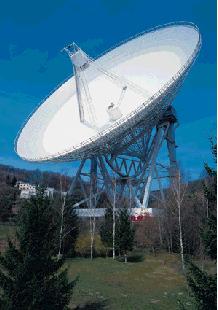Powerful polarimetric instruments
VLA
 Situated near Socorro, New Mexico, 27 antennas of 25-m diameter each, working as a single interferometer, reach high angular resolution corresponding to the largest separation (baseline) between antennas (up to 27km) and a sensitivity of 130-m full-filled antenna.
Situated near Socorro, New Mexico, 27 antennas of 25-m diameter each, working as a single interferometer, reach high angular resolution corresponding to the largest separation (baseline) between antennas (up to 27km) and a sensitivity of 130-m full-filled antenna.
The VLA is a powerful instrument for study of magnetic field in external, nearby galaxies. Because the polarized signal is an order of magnitude weaker than the total power one I use compact D-array (1.8km large) at few cm-wavelengths and C-array at 21cm for detailed polarimetric measurements of galaxies.
Next generation of interferometers as LOFAR, SKA and ALMA will open early univers galaxies for studies of origin of magnetic field.
Effelsberg
 100-m telescope in Effelsberg is a powerfull tool in searching magnetic field on kpc-scale in nearby galaxies. It is especially suitable for large galaxies and of low surface brightness in which case the VLA loss diffuse emission.
100-m telescope in Effelsberg is a powerfull tool in searching magnetic field on kpc-scale in nearby galaxies. It is especially suitable for large galaxies and of low surface brightness in which case the VLA loss diffuse emission.
In some cases the best choice is to combine interferometric and single-dish data. It was done in case of our study of NGC4449, and the Antennae galaxies.
For my students observing at Effelsberg I have prepared a short guide.
How I use them
A range of galaxies were observed in this way. My recent studies in collaboration with people from my institute, Max-Planck Institute fur Radioastronomie in Bonn, Bochum University and Meudon Observatory involve:
A sample of polarimetric studies of galaxies are also presented in the Magnetic Atlas of Galaxies.

 Situated near Socorro, New Mexico, 27 antennas of 25-m diameter each, working as a single interferometer, reach high angular resolution corresponding to the largest separation (baseline) between antennas (up to 27km) and a sensitivity of 130-m full-filled antenna.
Situated near Socorro, New Mexico, 27 antennas of 25-m diameter each, working as a single interferometer, reach high angular resolution corresponding to the largest separation (baseline) between antennas (up to 27km) and a sensitivity of 130-m full-filled antenna. 100-m telescope in Effelsberg is a powerfull tool in searching magnetic field on kpc-scale in nearby galaxies. It is especially suitable for large galaxies and of low surface brightness in which case the VLA loss diffuse emission.
100-m telescope in Effelsberg is a powerfull tool in searching magnetic field on kpc-scale in nearby galaxies. It is especially suitable for large galaxies and of low surface brightness in which case the VLA loss diffuse emission.